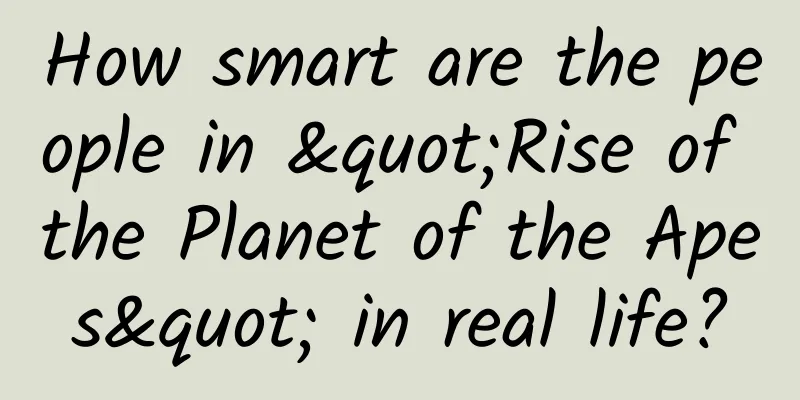How smart are the people in "Rise of the Planet of the Apes" in real life?

|
The movie "Rise of the Planet of the Apes" takes place hundreds of years after the rise of Caesar, and apes that have evolved into advanced intelligent creatures have become the rulers of the earth. But the movie is science fiction after all, so how smart are real animals? Intelligence is the ability to recognize and understand objective things and use knowledge and experience to solve problems, including memory, observation, imagination, thinking, judgment, problem solving, abstract thinking, expression of ideas and language learning. There are also different theories about the abilities included in intelligence. For example, the theory of multiple intelligences believes that intelligence includes language ability, logical mathematical ability, musical ability, spatial ability, physical movement ability, interpersonal relationship ability and self-awareness ability. According to the definition of intelligence, animals, including apes, have a certain level of intelligence. Although they cannot speak or write, animals have their own ways of communicating, and many animals can also understand human instructions through training. For example, chimpanzees can learn sign language, or communicate by placing chips or pictures. In terms of logical mathematical ability, adult chimpanzees can also count from one to nine. In the experiment, chimpanzees learned the Arabic numeral sequence 1 to 9 by pressing the numbers on the touch screen display in ascending order. Initially, the sequence always started with the number 1, that is, the "start fixed task", and the training started from 1-2, 1-2-3, and then went to 1-2-3-4-5-6-7-8-9. In the subsequent "end fixed task", the sequence started with random numbers, but always ended with 9. The performance of the end fixed task was worse than that of the familiar start fixed task. After training with various adjacent number sequences, the subjects were tested for transfer of non-adjacent numbers. The results of the study showed that all chimpanzees did master the sequential arrangement. For a long time, people believed that only humans could use tools. But scientists have long discovered that apes can also use tools to solve problems, and can even modify and process tools. They can cut branches into needles to catch ants, and they can also use stones to crack nuts. In an experiment, Austrian scientists tested the ability of orangutans to use tools. They put rewards in transparent tubes and provided orangutans with a piece of wire as a tool to obtain rewards. However, the orangutans could not get the rewards by directly using the wire. After the initial unsuccessful attempts, the orangutans transformed the wire into a handy tool by "biting and wrenching" and successfully took out the rewards. Not only apes, but some other animals also show high intelligence. Many people believe that dolphins have a high level of intelligence, including the recognition and understanding of themselves. The first step of self-awareness is to know "I am me". In the 1970s, psychologists in Amsterdam conducted the famous red dot experiment to explore the emergence of self-awareness. In this experiment, the experimenter put a red dot on the face of the research subject (baby) without the subject's awareness, and then observed the subject's reaction when looking in the mirror. When some research subjects saw a red dot on their face in the mirror, they knew that it was actually a red dot on their face, and they touched or wiped off the red dot with their hands. This shows that the baby can distinguish his own image, and this behavior can be regarded as the beginning of self-awareness. Human babies begin to realize that the image in the mirror is themselves at around two years old, and begin to touch the red dot on the corresponding position on their face with their hands, and self-awareness begins to form. The same research paradigm has also been used in animal research. For example, dolphins can quickly know that the person in the mirror is themselves, and can also explore invisible parts of their body, such as the inside of the mouth, through the reflection of the mirror. The measurement of human intelligence is usually done by answering questions or completing tasks, most often using questionnaires. But how do we measure the intelligence of animals that cannot read or write? Just like with children, this can be done through operational tests. Some studies test the memory and recognition of animals. For example, some researchers have designed a series of experiments using conditioned reflexes to test the intelligence of crows. For example, they hide worms under a flip board, and you have to flip it to eat the worms; or you put the worms under a flip board of a certain color, and you can only get the worms by choosing the right flip board; there are also tasks that hide the worms among a number of choices, and you have to remember which one has a reward in order to get the reward. Using conditioned reflexes, researchers have also found that animals have a certain ability to abstract and summarize, such as distinguishing between painters of different styles. In a Japanese study, researchers first trained pigeons to distinguish between paintings by the impressionist painter Monet and the abstract painter Picasso. But then, even if the pigeons were shown some works they had never seen before, or even works by other impressionists, the pigeons were able to accurately distinguish between the two different styles of paintings by style. Subsequent studies have also obtained similar results in animals such as mice, bees, and chimpanzees. The above are just relatively simple cognitive tasks, and some tasks examine more advanced thinking abilities. The two-cup test is an experiment on children's reasoning: the reward is hidden in one of the two cups, and then the child is shown that one of the two cups is empty. If the child can choose the other cup, it means that he has the ability to eliminate (if it is not in A, then in B). Infants can already master this ability at the age of one and a half, and most animals also have this ability. If the difficulty of the task increases, such as increasing to three or four cups, can the animals complete it? Researchers at Harvard University conducted an experiment on an African grey parrot named Griffin. In the four-cup test, the cups are divided into pairs of two, and there is a reward in one cup of each pair. First, an empty cup is displayed, and you need to choose the one with the reward from the remaining three (first eliminate the other uncertain pair, and then it becomes the classic two-cup problem). In fact, Griffin can do much more than that. Sometimes researchers will put two rewards: a small reward is placed in a certain cup, but there is a big reward that it particularly likes in another pair of cups, so Griffin must take the risk to choose one of the cups in the pair that is only half possible in order to eat the delicious food. Interestingly, if the risky choice fails, in the next round it will choose the more conservative cup that will definitely get a small reward. The intelligence of apes in movies is far greater than that in reality. The apes in the movies have mastered various abilities, while humans have completely degenerated and can't even speak. But whether it is reality or movies, it also reminds us to respect every species, because the earth is not just the earth of humans. Written by Wang Richu, Institute of Psychology, Chinese Academy of Sciences This article comes from: China Digital Science and Technology Museum |
<<: Flu ≠ Cold! Here’s how you should deal with the often-ignored flu →
>>: Break the prejudice, every age group should know the knowledge of cervical cancer
Recommend
15 lessons on financial management for women, teach you how to plan your household expenses from scratch and earn enough to buy a house at home
Her name is Wei Xiaowei, a mother of two who deal...
Millions of Android devices shipped with firmware vulnerabilities
Android smartphones from Asus, LG, Essential, and...
Golmud SEO Training: Keyword ranking is unstable, how can SEOer recover?
Website optimization is increasingly favored by e...
Jiucheng and Faraday Future signed a joint venture agreement to invest US$600 million
On the morning of March 25, Internet company The9...
New breakthrough in the exploration of extraterrestrial life, the "Drake Equation" may help solve it!
Drake equation crucial to calculating the amount ...
How to operate during the product stable period
A reader asked how he could make a breakthrough a...
Are there billions of pieces of space debris? Shenzhou 19 sets out to install a "golden bell cover" for the space station
At dawn on October 30, Cai Xuzhe, Song Lingdong a...
How to improve new user retention rate?
I have been busy at work recently, so I reposted ...
How important is the moon? Its gravity can pull the earth sideways!
The Earth has only one natural satellite, the Moo...
Aiti Tribe Stories (22): From fleeing from Beijing, Shanghai and Guangzhou to fleeing back to Beijing, Shanghai and Guangzhou
[51CTO.com original article] Sima Yu is Jiuge'...
Late? Actually they did it on purpose...
(Image source: BBC) Have you ever seen people lik...
A review of the top 10 advertising and marketing failures in 2021
2021 is coming to an end and the new year is abou...
SMMT: UK used car market to grow 4.3% in Q3 2024
According to the latest data released by the Soci...
How Much Do You Know About Spring Flowers? - A Guide to Viewing Spring Flowers of the Rosaceae Family (Part 1)
Produced by: Science Popularization China Author:...
[One Belt, One Road Story] The "pioneers" heading towards the sun
"A lone smoke rises straight in the desert, ...









